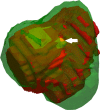Validation of a Web-Based Planning Tool for Percutaneous Cryoablation of Renal Tumors
- PMID: 32935141
- PMCID: PMC7591419
- DOI: 10.1007/s00270-020-02634-y
Validation of a Web-Based Planning Tool for Percutaneous Cryoablation of Renal Tumors
Abstract
Purpose: To validate a simulation environment for virtual planning of percutaneous cryoablation of renal tumors.
Materials and methods: Prospectively collected data from 19 MR-guided procedures were used for validation of the simulation model. Volumetric overlap of the simulated ablation zone volume (Σ) and the segmented ablation zone volume (S; assessed on 1-month follow-up scan) was quantified. Validation metrics were DICE Similarity Coefficient (DSC; the ratio between twice the overlapping volume of both ablation zones divided by the sum of both ablation zone volumes), target overlap (the ratio between the overlapping volume of both ablation zones to the volume of S; low ratio means S is underestimated), and positive predictive value (the ratio between the overlapping volume of both ablation zones to the volume of Σ; low ratio means S is overestimated). Values were between 0 (no alignment) and 1 (perfect alignment), a value > 0.7 is considered good.
Results: Mean volumes of S and Σ were 14.8 cm3 (± 9.9) and 26.7 cm3 (± 15.0), respectively. Mean DSC value was 0.63 (± 0.2), and ≥ 0.7 in 9 cases (47%). Mean target overlap and positive predictive value were 0.88 (± 0.11) and 0.53 (± 0.24), respectively. In 17 cases (89%), target overlap was ≥ 0.7; positive predictive value was ≥ 0.7 in 4 cases (21%) and < 0.6 in 13 cases (68%). This indicates S is overestimated in the majority of cases.
Conclusion: The validation results showed a tendency of the simulation model to overestimate the ablation effect. Model adjustments are necessary to make it suitable for clinical use.
Keywords: Computer-assisted image processing; Cryosurgery; Intraoperative monitoring; Kidney neoplasms; Preoperative care.
Conflict of interest statement
The authors declare that they have no conflict of interest.
Figures









Similar articles
-
Image registration of pre-procedural MRI and intra-procedural CT images to aid CT-guided percutaneous cryoablation of renal tumors.Int J Comput Assist Radiol Surg. 2011 Jan;6(1):111-7. doi: 10.1007/s11548-010-0485-9. Epub 2010 May 25. Int J Comput Assist Radiol Surg. 2011. PMID: 20499194 Free PMC article.
-
Cryoablation vs. radiofrequency ablation for small renal masses.Acad Radiol. 2011 Jan;18(1):97-100. doi: 10.1016/j.acra.2010.08.006. Epub 2010 Sep 29. Acad Radiol. 2011. PMID: 20880723
-
Image-guided percutaneous cryoablation of renal tumors.Tech Vasc Interv Radiol. 2007 Jun;10(2):140-8. doi: 10.1053/j.tvir.2007.09.009. Tech Vasc Interv Radiol. 2007. PMID: 18070692 Review.
-
Percutaneous MR-guided cryoablation for malignancies, with a focus on renal cell carcinoma.Int J Clin Oncol. 2007 Apr;12(2):79-84. doi: 10.1007/s10147-006-0654-6. Epub 2007 Apr 27. Int J Clin Oncol. 2007. PMID: 17443274 Review.
-
Percutaneous imaging-guided cryoablation of liver tumors: predicting local progression on 24-hour MRI.AJR Am J Roentgenol. 2014 Aug;203(2):W181-91. doi: 10.2214/AJR.13.10747. Epub 2014 Feb 20. AJR Am J Roentgenol. 2014. PMID: 24555531
Cited by
-
First validation of a model-based hepatic percutaneous microwave ablation planning on a clinical dataset.Sci Rep. 2023 Oct 6;13(1):16862. doi: 10.1038/s41598-023-42543-x. Sci Rep. 2023. PMID: 37803064 Free PMC article.
-
Image-Guided Adaptive Cryotherapy for Prostate Cancer Treatment.Ann Biomed Eng. 2025 Aug 29. doi: 10.1007/s10439-025-03833-9. Online ahead of print. Ann Biomed Eng. 2025. PMID: 40883549
-
AI-Based Isotherm Prediction for Focal Cryoablation of Prostate Cancer.Acad Radiol. 2023 Sep;30 Suppl 1(Suppl 1):S14-S20. doi: 10.1016/j.acra.2023.04.016. Epub 2023 May 24. Acad Radiol. 2023. PMID: 37236896 Free PMC article.
-
Hybrid Simulation and Planning Platform for Cryosurgery with Microsoft HoloLens.Sensors (Basel). 2021 Jun 29;21(13):4450. doi: 10.3390/s21134450. Sensors (Basel). 2021. PMID: 34209748 Free PMC article.
-
Iceball growth 3D simulation model based on finite element method for hepatic cryoablation planning.BMC Gastroenterol. 2025 Apr 7;25(1):227. doi: 10.1186/s12876-025-03817-y. BMC Gastroenterol. 2025. PMID: 40197246 Free PMC article.
References
Publication types
MeSH terms
Grants and funding
LinkOut - more resources
Full Text Sources
Medical

